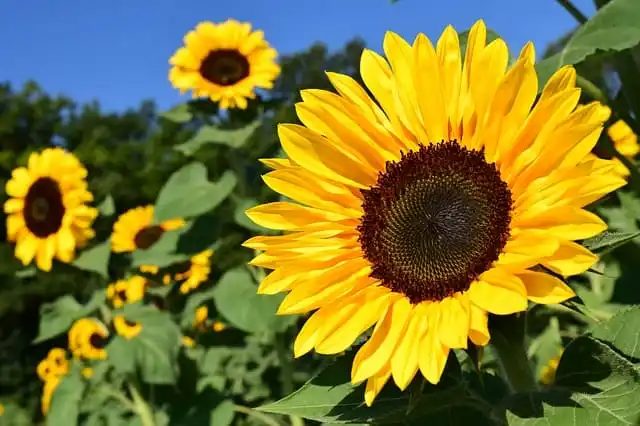Sunflowers (Helianthus annuus) are iconic, cheerful blooms that bring vibrancy to gardens and landscapes. Successfully growing sunflowers involves understanding their specific requirements and following best practices. This expert guide provides comprehensive instructions, referencing insights from government and horticultural bodies, as well as academic experts.
Choosing the Right Sunflower Variety
Selecting the appropriate sunflower variety is crucial for success. Different varieties vary in size, color, and suitability for different climates. Refer to recommendations from your local agricultural extension office or horticultural society to choose a variety that thrives in your region.
Site Selection and Soil Preparation
Sunflowers thrive in well-drained, fertile soil with a slightly acidic to neutral pH (6.0-7.5). Choose a sunny location, as sunflowers require at least 6-8 hours of direct sunlight daily. Test your soil and amend it with organic matter to improve fertility and drainage.
Planting Sunflower Seeds
Direct Sowing
Sow sunflower seeds directly into the soil after the last frost, spacing them according to the variety’s recommendations. Planting depth varies, so follow guidelines provided on the seed packet.
Seedlings
For a head start, start sunflower seeds indoors 2-4 weeks before the last expected frost. Transplant seedlings carefully into well-prepared soil, ensuring they have enough space to grow.
Watering and Fertilizing
Keep the soil consistently moist but not waterlogged during the growing season. Once established, sunflowers are somewhat drought-tolerant. Apply a balanced fertilizer at planting and again when the plants are about 12 inches tall, following package instructions.
Providing Support for Tall Varieties
Taller sunflower varieties may require support to prevent bending or breakage. Install stakes or a trellis when plants are about 12 inches tall, being careful not to damage the roots.
Pest and Disease Management
Monitor for common pests like aphids and caterpillars. Implement integrated pest management strategies recommended by local agricultural extension services to address issues specific to your region. Check for signs of diseases, and treat promptly.
Pruning and Deadheading
While sunflowers don’t require extensive pruning, removing dead or damaged leaves can promote airflow and reduce the risk of disease. Deadhead spent flowers to encourage continuous blooming and prevent self-seeding.
Harvesting Sunflower Seeds
Harvest sunflower seeds when the flower heads turn brown, and the back of the flower is yellow. Cut the heads, hang them upside down in a dry, well-ventilated space, and extract the seeds once fully dry. Academic experts often provide detailed guides on seed harvesting techniques.
Winter Care and Cleanup
In preparation for winter, cut down spent sunflower stalks and either compost or dispose of them to reduce the risk of disease. Cover the soil with a layer of mulch to insulate against freezing temperatures.
Community and Educational Resources
Explore community and educational resources for additional support and knowledge. Local horticultural societies, government agricultural extension offices, and academic institutions often provide workshops, publications, and online resources to aid sunflower growers. Utilize these sources for ongoing guidance.
Conclusion
Growing sunflowers can be a rewarding experience, bringing both beauty and practical uses like seeds for snacks and bird feed. By following these expert guidelines, incorporating insights from government and horticultural bodies, and referencing academic experts, you can cultivate a thriving display of these iconic flowers in your garden.
What are the ideal growing conditions for sunflowers?
Sunflowers thrive in full sun and well-drained soil. They prefer a location with at least 6-8 hours of direct sunlight daily for optimal growth and flowering.
Can I grow sunflowers in containers, or do they require a garden bed?
While sunflowers are typically grown in garden beds due to their height, certain dwarf or miniature varieties can be cultivated successfully in large containers. Ensure the containers have proper drainage.
When is the best time to plant sunflower seeds?
Sunflower seeds can be sown directly into the soil after the last frost in the spring. They germinate and grow best in warm soil conditions.
How do I care for sunflowers during the growing season?
Provide regular watering, especially during dry spells, and use a balanced fertilizer to promote healthy growth. Support tall varieties with stakes if needed, and consider deadheading to encourage continuous blooming.
Do sunflowers attract pollinators?
Yes, sunflowers are excellent pollinator attractors, drawing bees and butterflies to your garden. Their large, vibrant blooms are particularly appealing to these beneficial insects.
Can I save seeds from my sunflowers for planting the following year?
Absolutely! Allow the sunflower heads to mature and dry on the plant. Once the seeds are fully developed, harvest and store them in a cool, dry place for planting in the next growing season.
Are there different varieties of sunflowers, and how do I choose the right one for my garden?
Yes, there are numerous sunflower varieties, ranging in size, color, and shape. Consider the available space in your garden, the desired height, and the aesthetic preferences when choosing the right sunflower variety.
How tall do sunflowers typically grow?
The height of sunflowers varies depending on the variety. Dwarf varieties may reach 1-2 feet, while some giant varieties can grow up to 15 feet or more. Be sure to choose a variety that fits your garden space.
Do sunflowers require special soil preparation?
Sunflowers are adaptable to various soil types but prefer well-draining soil. Adding organic matter like compost before planting can enhance soil fertility and structure.
Can sunflowers be grown in colder climates or during the fall season?
While sunflowers are typically grown in warmer seasons, some shorter varieties can be successfully grown in cooler climates. Planting in the late spring or early summer ensures they have enough time to mature before the first frost.
- Rhode Island’s Favorite THC Infused Beverages - June 5, 2025
- THC Soda and Drink Options in Idaho - May 28, 2025
- Ohio’s Go-To THC Infused Beverages - May 28, 2025




